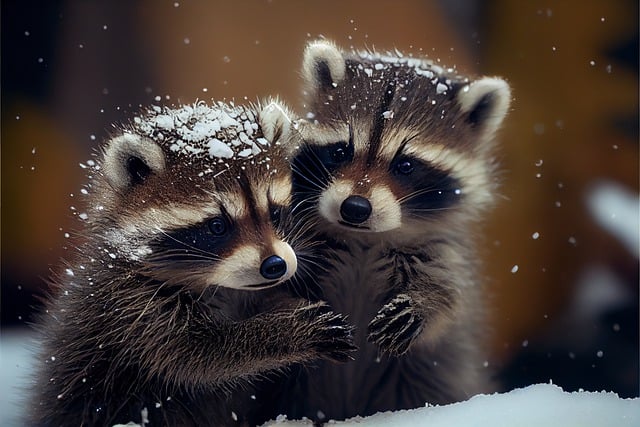Have you ever wondered where those mischievous raccoons in your neighborhood disappear when winter comes knocking? Well, I certainly did, and I couldn’t resist finding out and diving into the fascinating world of raccoon behavior during the chilly season. So, where do raccoons sleep in the winter season?
During the winter, raccoons seek shelter in various locations, including tree hollows, leafy nests in trees, ground burrows, and, in urban areas, abandoned buildings like barns or sheds. Raccoons can also venture into human-made structures such as attics, crawl spaces, garages, and chimneys, often through openings or damaged areas. They also don’t hibernate but enter a state called torpor, reducing their activity and metabolism to conserve energy.
In this article, I’ll debunk the hibernation myth, explore their winter hangouts, and even discuss ways to live harmoniously with these wildlife neighbors. Understanding their winter habits not only satisfies our curiosity but also helps us coexist peacefully with these crafty critters. Keep reading!
Raccoon Behavior in Winter
Winter – the magical time when the world transforms into a snowy wonderland. But what about our furry friends, the raccoons? Contrary to popular belief, raccoons don’t simply curl up and hibernate through the winter months. Let’s dive into their behavior during this chilly season.
A. Hibernation Myth Debunked
You’ve probably heard people say that raccoons hibernate in the winter. Well, let’s set the record straight: raccoons don’t actually hibernate. Instead, they enter a state known as torpor. Torpor is like a deep, prolonged nap where their metabolism slows down, but they can wake up and move around when necessary. It’s their way of conserving energy when food is scarce.
B. Activity Levels
Raccoons may not hibernate, but they do become less active during the winter. You won’t spot them raiding your garbage cans as often as in the summer. They’re not lazy; they’re just conserving energy. They’ll venture out on milder winter nights to forage for food, but they’re much less active compared to the warmer months.
C. Importance of Finding Suitable Shelter
Now, here’s the critical part of a raccoon’s winter survival story: shelter. Finding the right place to rest their furry heads is essential. After all, nobody wants to sleep in the freezing cold. Raccoons are pros at seeking out cozy hideaways where they can escape the harsh winter weather.
In the next section, we’ll explore the different types of shelters raccoons prefer during winter and where they choose to bed down for the season. Let’s unravel the mystery of their winter hideouts together!
Natural Raccoon Winter Habitats
As winter settles in, raccoons become experts at finding snug shelters to weather the cold. Let’s take a peek into their natural winter hideouts.
A. Tree Hollows and Nests
- Tree Hollows: Picture a raccoon nestled inside a hollowed-out tree trunk high above the ground. That’s a common winter retreat for these crafty creatures. Tree hollows provide excellent insulation and protection from predators and the elements.
- Nests: Raccoons aren’t just about tree hollows; they’re quite the homebuilders too. In preparation for winter, raccoons construct leafy nests high in the trees. These nests, called dreys, provide a cozy perch with a fantastic view while keeping them safe from winter’s chill.
B. Ground Burrows
- Digging In: When they’re not high in the treetops, raccoons may opt for the underground option. They are skilled diggers and often excavate burrows in the ground. These burrows serve as snug retreats, where they can ride out the cold and stay hidden from predators.
- Burrow Maintenance: Raccoons don’t just dig and forget. They’re quite particular about their winter homes. They’ll line the burrow with leaves, grass, and other insulating materials to create a toasty den.
C. Abandoned Structures
- Urban Explorers: Raccoons aren’t strangers to urban environments. When natural shelters are scarce, they might seek refuge in abandoned buildings. Old barns, sheds, and other structures offer warmth and protection from the elements.
- Human Conflicts: While these choices might keep raccoons cozy, they can sometimes lead to conflicts with humans. It’s important to find ways to coexist peacefully with our furry neighbors, even when they decide to bunk in our abandoned spaces.
Now that I’ve unveiled the raccoon’s preferred natural winter getaways, you’ll have a better understanding of where these clever creatures bed down during the colder months. But what if they choose to cozy up in your attic or garage? Don’t fret; I’ll tackle that in the next section.
Human-Made Structures
Raccoons, with their adaptable nature, sometimes opt for more human-centric lodgings during the winter. Let’s explore these unlikely winter hideaways and how to peacefully coexist with our masked, furry neighbors.
A. Attics and Crawl Spaces
- Uninvited Guests: Attics and crawl spaces might seem like cozy spots for raccoons, but having them as roommates isn’t ideal. Raccoons can access these spaces through damaged vents or openings, seeking refuge from the cold.
- Potential Problems: Having raccoons in your attic or crawl space can lead to structural damage, insulation issues, and health concerns due to their droppings. We’ll discuss prevention later on, so stay tuned!
B. Garages and Sheds
- A Warm Garage: Garages and sheds are often preferred by raccoons due to their warmth and shelter. It’s not uncommon to find raccoons snuggled up in a cozy corner amidst your gardening tools.
- Preventive Measures: We’ll share some handy tips on how to raccoon-proof these spaces, allowing you to maintain the sanctity of your garage and shed while keeping raccoons at bay.
C. Chimneys
- Down the Chimney: Believe it or not, raccoons occasionally find their way into chimneys. These tall, dark spaces can be appealing, but it can be quite the challenge for them to get in and out.
- Preventing Chimney Entry: We’ll discuss methods to prevent raccoons from taking residence in your chimney and how to safely remove them if they do find their way down.
It’s essential to know how to deter them from setting up camp in your attic, garage, or chimney. I’ll delve into coexistence strategies in the next section, ensuring a harmonious living arrangement with these crafty critters.
Coexisting with Wintering Raccoons
So, you’ve discovered that raccoons might be sharing your space during the winter. Don’t worry; there are ways to peacefully coexist with these resourceful creatures. Let’s explore strategies for harmonious living with wintering raccoons.
A. Importance of Wildlife Removal Professionals
- Seek Professional Help: If raccoons have taken up residence in your attic, crawl space, or chimney, it’s best to call in wildlife removal professionals. They are trained to handle raccoon removal safely and humanely.
- Humane Removal: Emphasize the importance of humane removal practices. Ethical treatment of raccoons ensures they are relocated safely and unharmed, allowing them to thrive in their natural habitats.
B. Securing Food Sources
- Trash Cans and Pet Food: Raccoons are notorious scavengers. Keep trash cans securely latched and consider using wildlife-proof bins. Also, bring in pet food bowls overnight to avoid attracting these critters.
- Compost Piles: If you compost, make sure your pile is well-secured. Raccoons can be attracted to the smell of food scraps.
C. Home Repairs and Deterrents
- Sealing Entry Points: Prevent raccoons from entering your home by sealing any potential entry points. Repair damaged vents, chimneys, and gaps in your roof or siding.
- Deterrents: Install motion-activated lights or sprinklers to deter raccoons from frequenting your property. These devices can startle them and encourage them to seek shelter elsewhere.
- Safe Trapping: In some cases, if raccoons become a persistent problem, consider using humane live traps. Check local regulations and, if necessary, contact animal control or a wildlife rehabilitator for guidance on safe trapping and relocation.
By taking these coexistence measures, you can create a peaceful environment for both you and your raccoon neighbors. It’s possible to share the same space with these clever critters without any major conflicts.
Conclusion
And there you have it, folks – the secret lives of raccoons during the winter months, revealed! Raccoons are not the hibernating sleepers many often imagine. Instead, they enter a state of torpor, reducing their activity but remaining alert and mobile. Finding suitable shelter is crucial for their survival, leading them to cozy tree hollows, leafy nests, ground burrows, and even human-made structures like attics, garages, and chimneys.
When it comes to coexisting with wintering raccoons, remember these key points:
- Seek professional help for humane raccoon removal if they intrude into your home.
- Secure food sources like trash cans and pet food to prevent attraction.
- Take preventive measures such as sealing entry points and using deterrents.
- If necessary, consider humane trapping and relocation with expert guidance.
Raccoons are remarkable creatures, and by understanding their needs and behaviors, we can share our spaces with them peacefully. So, as the snow falls and the temperature drops, let’s foster a sense of coexistence, allowing both humans and raccoons to enjoy a comfortable winter.
Thank you for joining me on this journey to uncover “Where Do Raccoons Sleep in the Winter?” Stay curious and compassionate towards the wildlife that shares our world. Until next time, happy coexisting!
Here is another great question answered: How Far Do Raccoons Travel In A Night?










